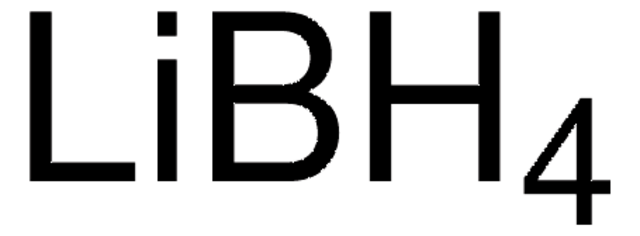If this product has an expiration or retest date, it will be shown on the Certificate of Analysis (COA, CofA). If there is no retest or expiration date listed on the product's COA, we do not have suitable stability data to determine a shelf life. For these products, the only date on the COA will be the release date; a retest, expiration, or use-by-date will not be displayed.
For all products, we recommend handling per defined conditions as printed in our product literature and website product descriptions. We recommend that products should be routinely inspected by customers to ensure they perform as expected.
For products without retest or expiration dates, our standard warranty of 1 year from the date of shipment is applicable.
For more information, please refer to the Product Dating Information document: https://www.sigmaaldrich.com/deepweb/assets/sigmaaldrich/marketing/global/documents/449/386/product-dating-information-mk.pdf
230200
Lithium borohydride solution
2.0 M in THF
Synonyme(s) :
Lithium boron hydride, Lithium hydroborate
About This Item
Produits recommandés
Forme
liquid
Niveau de qualité
Pertinence de la réaction
reagent type: reductant
Concentration
2.0 M in THF
Densité
0.896 g/mL at 25 °C
Chaîne SMILES
[Li+].[H][B-]([H])([H])[H]
InChI
1S/BH4.Li/h1H4;/q-1;+1
Clé InChI
UUKMSDRCXNLYOO-UHFFFAOYSA-N
Vous recherchez des produits similaires ? Visite Guide de comparaison des produits
Catégories apparentées
Application
- Preparation of gallium, indium, rhenium and zinc tris(mercaptoimidazolyl)hydroborato complexes
- Mechano-chemical metathesis reactions
- Noncatalytic hydrolysis for hydrogen generation
- Growth of large gold monolayer protected-clusters
- Anion substitution reactions
- Dehydrogenation reactions
Conditionnement
Informations légales
Mention d'avertissement
Danger
Mentions de danger
Classification des risques
Acute Tox. 4 Oral - Carc. 2 - Eye Dam. 1 - Flam. Liq. 2 - Skin Corr. 1B - STOT SE 3 - Water-react 1
Organes cibles
Central nervous system, Respiratory system
Risques supp
Code de la classe de stockage
4.3 - Hazardous materials which set free flammable gases upon contact with water
Classe de danger pour l'eau (WGK)
WGK 2
Point d'éclair (°F)
-0.4 °F - closed cup
Point d'éclair (°C)
-18 °C - closed cup
Équipement de protection individuelle
Eyeshields, Faceshields, Gloves, type ABEK (EN14387) respirator filter
Faites votre choix parmi les versions les plus récentes :
Déjà en possession de ce produit ?
Retrouvez la documentation relative aux produits que vous avez récemment achetés dans la Bibliothèque de documents.
Les clients ont également consulté
-
How can I determine the shelf life / expiration / retest date of this product?
1 réponse-
Utile ?
-
-
How is shipping temperature determined? And how is it related to the product storage temperature?
1 réponse-
Products may be shipped at a different temperature than the recommended long-term storage temperature. If the product quality is sensitive to short-term exposure to conditions other than the recommended long-term storage, it will be shipped on wet or dry-ice. If the product quality is NOT affected by short-term exposure to conditions other than the recommended long-term storage, it will be shipped at ambient temperature. As shipping routes are configured for minimum transit times, shipping at ambient temperature helps control shipping costs for our customers. For more information, please refer to the Storage and Transport Conditions document: https://www.sigmaaldrich.com/deepweb/assets/sigmaaldrich/marketing/global/documents/316/622/storage-transport-conditions-mk.pdf
Utile ?
-
-
Is the tetrahydrofuran (THF) used in Product 230200, Lithium Borohydride, stabilized?
1 réponse-
The THF used in this product is stabilized with 0.025% butylated hydroxytoluene (BHT).
Utile ?
-
-
Is Product 230200, Lithium Borohydride, an energy carrier?
1 réponse-
Lithium borohydride is renowned for one of the highest energy density chemical energy carriers. By reacting with atmospheric oxygen, it liberates large amounts of heat.
Utile ?
-
-
What is the Department of Transportation shipping information for this product?
1 réponse-
Transportation information can be found in Section 14 of the product's (M)SDS.To access the shipping information for this material, use the link on the product detail page for the product.
Utile ?
-
-
What types of reactions is Product 230200, Lithium Borohydride, used in?
1 réponse-
It is reagent for reduction of compounds containing ketonic, aldehydic, or ester carbonyls and a nitrile group, where reduction of the carbonyl but not of the nitrile group is wanted.
Utile ?
-
-
Why does Product 230200, Lithium Borohydride, need to be handled under nitrogen?
1 réponse-
This product is moisture sensitive, reacting violently with water, liberating extremely flammable gases.
Utile ?
-
-
Is it necessary to refrigerate Product 230200, Lithium Borohydride?
1 réponse-
We do recommend to refrigerate this product, since it may develop pressure at room temperature.
Utile ?
-
Filtres actifs
Notre équipe de scientifiques dispose d'une expérience dans tous les secteurs de la recherche, notamment en sciences de la vie, science des matériaux, synthèse chimique, chromatographie, analyse et dans de nombreux autres domaines..
Contacter notre Service technique














